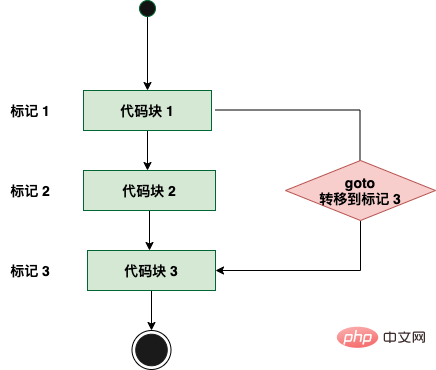 Backend Development
Backend Development
 C#.Net Tutorial
C#.Net Tutorial
 What are the statements that can be used to change the flow of a loop statement in C language?
What are the statements that can be used to change the flow of a loop statement in C language?
What are the statements that can be used to change the flow of a loop statement in C language?
The statements that can be used to change the flow of a loop statement in C language are: break, continue and goto. The break statement can terminate the loop and execute the code behind the entire loop statement; the continue statement can skip the remaining statements in the loop body and force entry into the next loop.

The operating environment of this tutorial: windows7 system, c99 version, Dell G3 computer.
break keyword
When the break keyword is used in while and for loops, the loop will be terminated and the code behind the entire loop statement will be executed. The break keyword is usually used together with the if statement to break out of the loop when the condition is met.
Use a while loop to calculate the value of 1 added to 100:
#include <stdio.h>
int main(){
int i=1, sum=0;
while(1){ //循环条件为死循环
sum+=i;
i++;
if(i>100) break;
}
printf("%d\n", sum);
return 0;
}Running result:
5050
while loop condition is 1, which is an infinite loop. When the 100th loop is executed, the value of i after calculating i is 101. At this time, the condition of the if statement i> 100 is established, and the break; statement is executed to end the loop.
In a multi-level loop, a break statement only jumps one level outward. For example, output a 4*4 integer matrix:
#include <stdio.h>
int main(){
int i=1, j;
while(1){ // 外层循环
j=1;
while(1){ // 内层循环
printf("%-4d", i*j);
j++;
if(j>4) break; //跳出内层循环
}
printf("\n");
i++;
if(i>4) break; // 跳出外层循环
}
return 0;
}Operation result:
1 2 3 4 2 4 6 8 3 6 9 12 4 8 12 16
When j>4 is established, execute break; and jump out of the inner loop; the outer loop is still executed, Until i>4 is established, jump out of the outer loop. The inner loop is executed a total of 4 times, and the outer loop is executed once.
continue statement
The function of the continue statement is to skip the remaining statements in the loop body and force entry into the next loop. The continue statement is only used in while and for loops, and is often used together with the if conditional statement to determine whether the condition is true.
Let’s take a look at an example:
#include <stdio.h>
int main(){
char c = 0;
while(c!='\n'){ //回车键结束循环
c=getchar();
if(c=='4' || c=='5'){ //按下的是数字键4或5
continue; //跳过当次循环,进入下次循环
}
putchar(c);
}
return 0;
}Running result:
0123456789↙ 01236789
When the program encounters while, the value of variable c is '\0', and the loop condition c!=' \n' is established and the first cycle starts. getchar() causes the program to pause execution, wait for user input, and does not start reading characters until the user presses the Enter key.
In this example, we input 0123456789. When 4 or 5 is read, the if condition c=='4'||c=='5' is established, and the continue statement is executed to end the current loop. , directly enter the next loop, which means putchar(c); will not be executed. When other numbers are read, the if condition does not hold, the continue statement will not be executed, and putchar(c); will output the read characters.
Comparison between break and continue: break is used to end all loops, and the loop statement no longer has a chance to be executed; continue is used to end the current loop and jump directly to the next loop, if the loop condition is true , and the cycle will continue.
goto statement
The goto statement in C language allows unconditional transfer of control to a marked statement within the same function.
Note: It is not recommended to use goto statement in any programming language. Because it makes the control flow of the program difficult to track, making the program difficult to understand and modify. Any program that uses goto statements can be rewritten in a way that does not require goto statements.
The syntax of the goto statement in C language:
goto label; .. . label: statement;
Here, label can be any plain text except C keywords, and it can be set before or after the goto statement in the C program .

Flow chart

Example:
#include <stdio.h>
int main ()
{
/* 局部变量定义 */
int a = 10;
/* do 循环执行 */
LOOP:do
{
if( a == 15)
{
/* 跳过迭代 */
a = a + 1;
goto LOOP;
}
printf("a 的值: %d\n", a);
a++;
}while( a < 20 );
return 0;
}When the above code is compiled and executed , it will produce the following results:
a 的值: 10 a 的值: 11 a 的值: 12 a 的值: 13 a 的值: 14 a 的值: 16 a 的值: 17 a 的值: 18 a 的值: 19
For more programming-related knowledge, please visit: Introduction to Programming! !
The above is the detailed content of What are the statements that can be used to change the flow of a loop statement in C language?. For more information, please follow other related articles on the PHP Chinese website!

Hot AI Tools

Undresser.AI Undress
AI-powered app for creating realistic nude photos

AI Clothes Remover
Online AI tool for removing clothes from photos.

Undress AI Tool
Undress images for free

Clothoff.io
AI clothes remover

Video Face Swap
Swap faces in any video effortlessly with our completely free AI face swap tool!

Hot Article

Hot Tools

Notepad++7.3.1
Easy-to-use and free code editor

SublimeText3 Chinese version
Chinese version, very easy to use

Zend Studio 13.0.1
Powerful PHP integrated development environment

Dreamweaver CS6
Visual web development tools

SublimeText3 Mac version
God-level code editing software (SublimeText3)

Hot Topics
 1664
1664
 14
14
 1422
1422
 52
52
 1316
1316
 25
25
 1266
1266
 29
29
 1239
1239
 24
24
 C language data structure: data representation and operation of trees and graphs
Apr 04, 2025 am 11:18 AM
C language data structure: data representation and operation of trees and graphs
Apr 04, 2025 am 11:18 AM
C language data structure: The data representation of the tree and graph is a hierarchical data structure consisting of nodes. Each node contains a data element and a pointer to its child nodes. The binary tree is a special type of tree. Each node has at most two child nodes. The data represents structTreeNode{intdata;structTreeNode*left;structTreeNode*right;}; Operation creates a tree traversal tree (predecision, in-order, and later order) search tree insertion node deletes node graph is a collection of data structures, where elements are vertices, and they can be connected together through edges with right or unrighted data representing neighbors.
 The truth behind the C language file operation problem
Apr 04, 2025 am 11:24 AM
The truth behind the C language file operation problem
Apr 04, 2025 am 11:24 AM
The truth about file operation problems: file opening failed: insufficient permissions, wrong paths, and file occupied. Data writing failed: the buffer is full, the file is not writable, and the disk space is insufficient. Other FAQs: slow file traversal, incorrect text file encoding, and binary file reading errors.
 How debian readdir integrates with other tools
Apr 13, 2025 am 09:42 AM
How debian readdir integrates with other tools
Apr 13, 2025 am 09:42 AM
The readdir function in the Debian system is a system call used to read directory contents and is often used in C programming. This article will explain how to integrate readdir with other tools to enhance its functionality. Method 1: Combining C language program and pipeline First, write a C program to call the readdir function and output the result: #include#include#include#includeintmain(intargc,char*argv[]){DIR*dir;structdirent*entry;if(argc!=2){
 CS-Week 3
Apr 04, 2025 am 06:06 AM
CS-Week 3
Apr 04, 2025 am 06:06 AM
Algorithms are the set of instructions to solve problems, and their execution speed and memory usage vary. In programming, many algorithms are based on data search and sorting. This article will introduce several data retrieval and sorting algorithms. Linear search assumes that there is an array [20,500,10,5,100,1,50] and needs to find the number 50. The linear search algorithm checks each element in the array one by one until the target value is found or the complete array is traversed. The algorithm flowchart is as follows: The pseudo-code for linear search is as follows: Check each element: If the target value is found: Return true Return false C language implementation: #include#includeintmain(void){i
 How to output a countdown in C language
Apr 04, 2025 am 08:54 AM
How to output a countdown in C language
Apr 04, 2025 am 08:54 AM
How to output a countdown in C? Answer: Use loop statements. Steps: 1. Define the variable n and store the countdown number to output; 2. Use the while loop to continuously print n until n is less than 1; 3. In the loop body, print out the value of n; 4. At the end of the loop, subtract n by 1 to output the next smaller reciprocal.
 C language multithreaded programming: a beginner's guide and troubleshooting
Apr 04, 2025 am 10:15 AM
C language multithreaded programming: a beginner's guide and troubleshooting
Apr 04, 2025 am 10:15 AM
C language multithreading programming guide: Creating threads: Use the pthread_create() function to specify thread ID, properties, and thread functions. Thread synchronization: Prevent data competition through mutexes, semaphores, and conditional variables. Practical case: Use multi-threading to calculate the Fibonacci number, assign tasks to multiple threads and synchronize the results. Troubleshooting: Solve problems such as program crashes, thread stop responses, and performance bottlenecks.
 How to define the call declaration format of c language function
Apr 04, 2025 am 06:03 AM
How to define the call declaration format of c language function
Apr 04, 2025 am 06:03 AM
C language functions include definitions, calls and declarations. Function definition specifies function name, parameters and return type, function body implements functions; function calls execute functions and provide parameters; function declarations inform the compiler of function type. Value pass is used for parameter pass, pay attention to the return type, maintain a consistent code style, and handle errors in functions. Mastering this knowledge can help write elegant, robust C code.
 Integers in C: a little history
Apr 04, 2025 am 06:09 AM
Integers in C: a little history
Apr 04, 2025 am 06:09 AM
Integers are the most basic data type in programming and can be regarded as the cornerstone of programming. The job of a programmer is to give these numbers meanings. No matter how complex the software is, it ultimately comes down to integer operations, because the processor only understands integers. To represent negative numbers, we introduced two's complement; to represent decimal numbers, we created scientific notation, so there are floating-point numbers. But in the final analysis, everything is still inseparable from 0 and 1. A brief history of integers In C, int is almost the default type. Although the compiler may issue a warning, in many cases you can still write code like this: main(void){return0;} From a technical point of view, this is equivalent to the following code: intmain(void){return0;}



